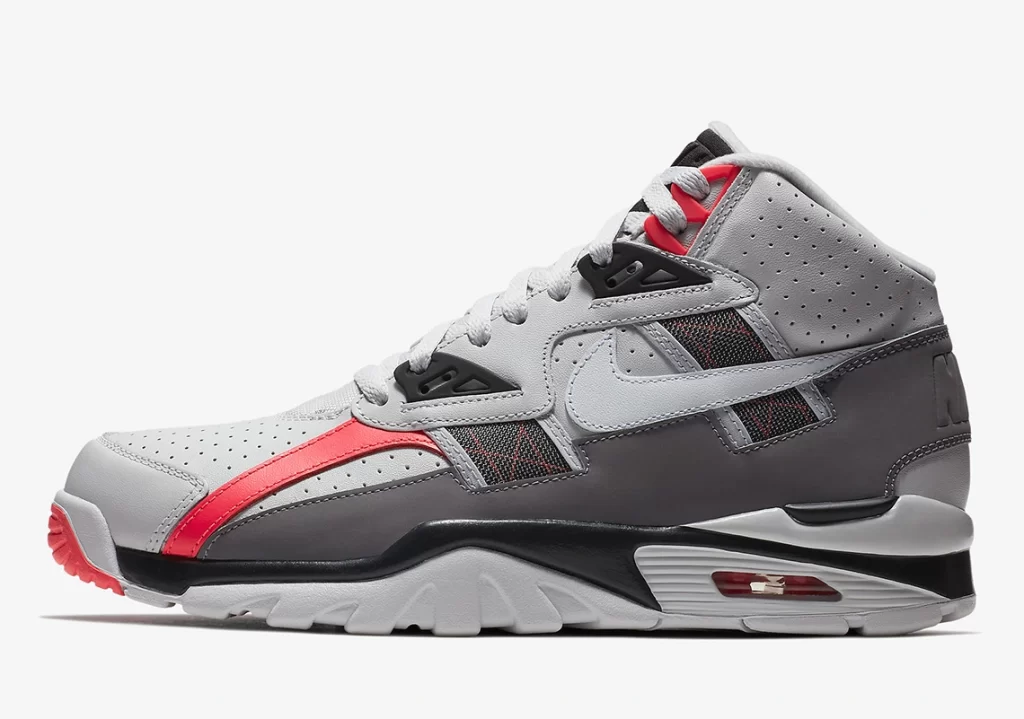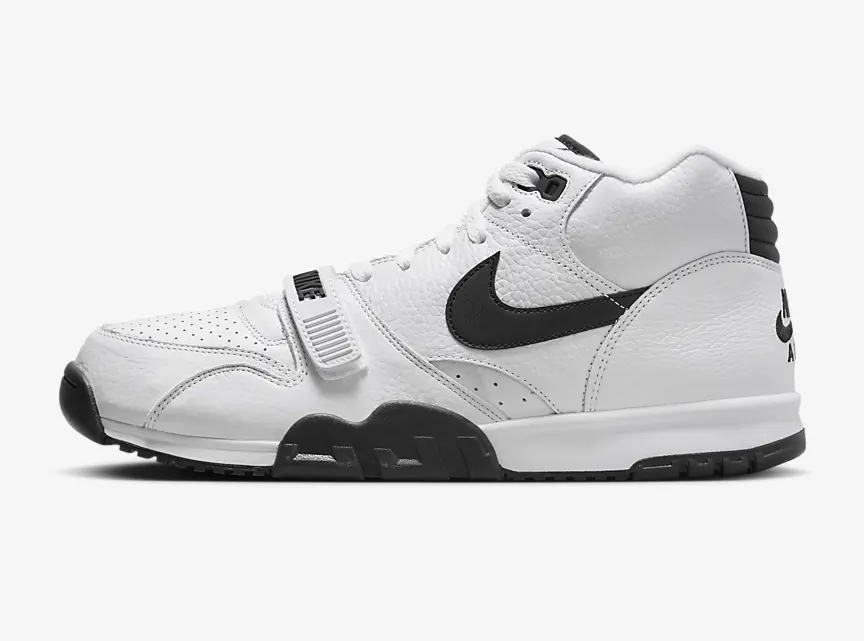The Nike Air Trainer is one of the most iconic sneakers in the history of athletic footwear, with a legacy that spans over three decades. Initially released in 1987, the Air Trainer was designed as a cross-training shoe suitable for various athletic activities. Since then, the Air Trainer has undergone numerous iterations and updates, each one building upon the strengths of the previous model. From its groundbreaking design to its association with iconic athletes, the Air Trainer has left an indelible mark on the world of sneakers.
In this article, we will explore the history and legacy of the Nike Air Trainer, examining its design, evolution, and enduring influence on the world of athletic footwear. So let’s dig deeper!
Origin of the Nike Air Trainer
The Nike Air Trainer 1 was created out of a combination of necessity and creative inspiration. Before its introduction in 1987, no multipurpose sneaker was available to meet the diverse needs of athletes. They had to carry multiple shoes to the gym for different activities such as running, basketball, weightlifting, and racquetball.
To address this issue, Tinker Hatfield, a Nike designer, took it upon himself to develop a sneaker that could cater to various physical activities. He believed that athletes shared his frustration, which fueled his determination to create a versatile, high-performance sneaker to meet their needs.
Tinker Hatfield’s idea for the Nike Air Trainer 1 was initially met with skepticism by some of his coworkers, who occasionally found his ideas distracting. The marketing division, in particular, dismissed the project as “pretty stupid,” believing that it would detract from sales in the more popular categories of basketball and running shoes. However, Hatfield remained confident in his vision, aware that his colleagues could not see its potential.
Despite the initial resistance, Hatfield had the support of his friend and collaborator, Mark Parker, who managed research and development and later became Nike’s CEO. Parker recognized the value of Hatfield’s idea and encouraged him to move forward with the project.
With Parker’s support, Hatfield brought his vision for the Nike Air Trainer 1 to life. In 1987, Nike released the Air Trainer Hi, a revolutionary sneaker that combined features of both basketball and running shoes. The heel lift was slightly higher than a basketball shoe but lower than a running shoe, providing optimal support for various physical activities. Additionally, the shoe featured a lateral outrigger that improved stability and support, making it ideal for high-intensity workouts.
One of the Air Trainers Hi’s most distinctive feature was a forefoot strap that allowed a customizable lockdown fit. The shoe was crafted from a combination of leather and nubuck. It featured a color scheme of gray, white, and black with hints of the iconic Chlorophyll Green that would become synonymous with the Air Trainer line.

The Air Trainer Hi was released during a pivotal period in Nike’s history, alongside other groundbreaking sneakers such as the Air Max 1 and the Revolution. The introduction of visible Nike Air technology in these shoes marked a turning point for the company, establishing Nike as a leader in innovative sneaker design and technology.
Upon its release, the Air Trainer 1 was immediately enthralled by athletes of all levels, from weekend warriors to professional athletes. The sneaker’s versatility and ability to perform well in various physical activities quickly made it a popular choice among fitness enthusiasts.
The success of Air Trainer 1 was a testament to Hatfield’s visionary approach to design and his ability to identify a gap in the market. By creating a shoe that could perform well in various physical activities, he opened up a new world of possibilities for athletes and fitness enthusiasts.
Impact of the Nike Air Trainer on the Athletic Shoe Industry
The Nike Air Trainer was a game-changer in the athletic shoe industry, revolutionizing how people thought about footwear for different sports and activities. It disrupted the market by introducing a new category of athletic shoes. This cross-trainer combined features from other types of footwear to create a versatile shoe that could be used for multiple sports and activities.
Before the Nike Air Trainer, athletes typically used specific shoes for each sport or activity. For example, runners would wear running shoes, basketball players would wear basketball shoes, and weightlifters would wear weightlifting shoes. It meant that athletes had to switch shoes depending on their activity, which could be inconvenient and time-consuming.
The Nike Air Trainer changed this by introducing a shoe designed to perform well in various activities. The shoe’s unique design, which combined features from basketball shoes, running shoes, and weightlifting shoes, allowed athletes to use a single shoe for multiple activities, which was a significant disruption to the athletic shoe market as it challenged the traditional way of thinking about footwear for different sports.
The success of the Nike Air Trainer also paved the way for other cross-training shoes, which became increasingly popular throughout the 1990s. This new shoe category not only provided convenience for athletes but also helped improve performance by offering the support and stability needed for various activities.
Famous Athletes Who Wore the Nike Air Trainer
The Nike Air Trainer is a legendary shoe worn by numerous famous athletes throughout history.
Bo Jackson was one of the most famous athletes to wear the Nike Air Trainer. The Nike Air Trainer was first released in 1987, the same year Jackson was drafted by the NFL’s Oakland Raiders. As a two-sport athlete playing professional football and baseball, Jackson needed a shoe that provided excellent support and stability, and the Nike Air provided the support and stability he needed to make quick cuts and change direction on the field, which helped him evade defenders and make big plays.
John McEnroe is still the most well-known “wild child” in tennis history. Like Air Trainer 1, McEnroe disregarded social conventions, and his bold demeanor helped him become a household name. Nike’s Peter Moore gave McEnroe a pair with the instruction to wear them for activities besides tennis. McEnroe immediately wore the Air Trainer 1 to a tennis match in Palm Springs that he won. Nike decided to give McEnroe his way and made him two special PEs. One had a clay court-specific herringbone outsole pattern inspired by the Nike Tennis, a shoe McEnroe wore earlier in the 1980s, while the other had a toothed version of the Air Trainer 1’s normal sole made for grass courts.
Andre Agassi was another famous athlete who wore the Nike Air Trainer. Agassi was a tennis player known for his flashy style and powerful groundstrokes. Agassi first started wearing the Nike Air Trainer during the 1990 French Open. Agassi’s endorsement of the Nike Air Trainer helped make the shoe one of the most popular cross-training shoes of the 1990s. The shoe became a must-have for athletes of all sports, and its association with Agassi helped make it a fashion statement.
These athletes and many others have helped make the Nike Air Trainer a legendary shoe that is still popular today. The shoe’s innovative design and support have helped athletes perform at their best, contributing to their success and popularity.
The Evolution of the Nike Air Trainer
The Nike Air Trainer has evolved significantly since its first release in 1987. From changes in design, technology, and marketing strategies, the shoe has continued to adapt and innovate over the years.
Design Evolution:
The original Nike Air Trainer was designed as a cross-training shoe featuring a midfoot strap and a unique outsole design to provide support and stability during various activities. Over time, the shoe’s design has evolved to meet the changing needs of athletes and fashion trends. For example, in the early 1990s, the Nike Air Trainer SC II was released, which featured a thicker midsole and a more aggressive outsole design for better traction. In the 2000s, the shoe’s design became sleeker and more streamlined with the introduction of the Nike Air Trainer Huarache and other models.
Technology Evolution:
The Nike Air Trainer has always been known for its innovative use of technology, and the shoe has continued to evolve with advancements in cushioning and support. For example, the Nike Air Trainer Max 2 ’94 introduced a visible Air Max unit in the heel for cushioning and shock absorption. The Nike Air Trainer Huarache featured a neoprene inner sleeve and a supportive exoskeleton for a more customized fit. Today, the Nike Air Trainer continues to incorporate the latest technology, with models like the Nike Air Trainer 3 featuring a Phylon midsole and forefoot strap for improved support and stability.
Marketing Evolution:
The Nike Air Trainer’s marketing strategy has also evolved. In the 1990s, Nike’s advertising campaigns for the shoe focused on the idea of cross-training and the versatility of the shoe. The company also used celebrity endorsements, like those of Bo Jackson and Andre Agassi, to help promote the shoe. In recent years, Nike has used social media and influencer marketing to reach a younger audience with campaigns highlighting the shoe’s style and comfort.
The Legacy of the Nike Air Trainer
The Nike Air Trainer has an enduring legacy that continues to influence the world of athletic footwear. One of the key reasons for its lasting relevance is its groundbreaking design, which was ahead of its time when it was first introduced in 1987. The Air Trainer was one of the first sneakers to incorporate Nike’s Air cushioning technology, which provides unparalleled comfort and support for athletes.
Another reason for the Air Trainer’s enduring popularity is its versatility. The sneaker was marketed as a cross-training shoe suitable for a wide range of athletic activities, from weightlifting to running to basketball. This versatility has helped to cement the Air Trainer as a classic sneaker that can be worn both on and off the court.
The Air Trainer has also been worn by some of the most iconic athletes in history, including Bo Jackson, who famously endorsed the sneaker in a series of memorable commercials. This association with elite athletes has helped to elevate the Air Trainer’s status in the sneaker world and cement its place as a classic.
In recent years, Nike has released updated versions of the Air Trainer, incorporating new materials and technology to enhance the sneaker’s performance and comfort further. These updates have helped to keep the Air Trainer relevant in a rapidly evolving sneaker market.
The Nike Air Trainer’s legacy is due to its groundbreaking design, versatility, association with iconic athletes, and continued evolution. As long as athletes demand high-performance footwear and sneaker enthusiasts continue to seek classic and stylish kicks, the Nike Air Trainer will remain a relevant and influential sneaker for years.
Conclusion
In conclusion, the Nike Air Trainer has a rich history and a lasting legacy that has impacted the athletic shoe industry, popular culture, and society. From its humble beginnings as a cross-training shoe to its cultural icon status, the Nike Air Trainer has evolved and adapted to meet the needs and demands of athletes and consumers alike. Its innovative design, functionality, and style have made it a timeless classic with a lasting influence on the sneaker industry and beyond. The Nike Air Trainer is a true testament to the power of innovation and design, and its legacy will undoubtedly continue to inspire and influence future generations.
